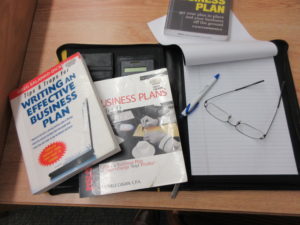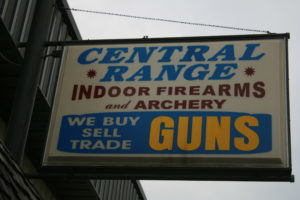A business plan can help focus on what attracts customers, keeps them coming back and how to better serve them. A plan can also help discover potential sales growth areas. (Photo: Michael D. Faw)
Two gun shops are located in a small rural town. The owners of both work long hours to increase customers entering the front door and to generate cash register rings. While both shops are doing okay, one is moving ahead of the across-town competition—far ahead. The one with improved success has taken a strong step to success by operating more like a business—and less like a hobby. That store developed a business plan.
Business plans offer many benefits but do require an investment of time and resources. The best plans can cost money to implement, can sometimes be overwhelming to create and require a lot of thought, introspection and soul searching. On the upside, a thorough plan requires putting everything on paper and helps the owner clearly set goals and see the BIG picture of the business. The overall process of creating a business plan can help nearly any store take stock of what is working—and determine what is not.
Putting The Plan On Paper
Putting pencil to paper and creating a business plan can provide many benefits, and the results can far outweigh the expense, time and stress associated with creating that plan. Developing a written business plan can help set clear objectives, turn educated guesses into focused facts and can help set priorities while better understanding how the many parts (such as marketing and sales) are interconnected. A business plan can also help to better understand cash flow — or be used when asking a bank for a loan. Sometimes it’s best to create a business plan on your laptop so you can read, write and review it to make ongoing changes.
While there are tomes of books touting that you can write a business plan in an hour, you need to take stock and set goals, plus hone in on the many small but important details. That could take a couple of days/evenings after the door closes, or maybe a few weeks to look at inventories, orders, IRS tax filings, bank loans, etc. Yes, much of building a business plan is basic number crunching, but look at it as a way to increase the important numbers—and possibly increasing the dollars coming into the business.

There are numerous guides to help prepare a thorough business plan. Consulting several may provide the best results as you put pencil to paper for the plan. (Photo: Michael D. Faw)
The Benefits Vs. Costs
Business plans also offer a huge benefit by laying the groundwork for growth and focusing on the overall business—or the BIG picture—and the desired business outcomes in the months and years ahead. A business plan can help estimate—or guesstimate—the current and future conditions of the company along with considerations of the shooting sports industry and overall business environment in the local community or region. A well-prepared business plan may encourage shifting resources into potential growth areas and moving away from items and practices that could be taking away resources or providing little return on investment (ROI).
When planning, a first important step is to develop a mission statement: Why does the business exist, and who are the customers? Some shops serve the tactical community, others cater to hunters and other shooting sports retailers try mostly to reach blue-collar folks with CCW permits. A next step could be to focus on the future and set some goals or desired results that will make the business successful—or more successful. Nearly everyone wants to profit and grow. Not being profitable means the doors will soon be locked and the CLOSED sign hanging.
By many estimates, the costs of starting a solid business plan begins at about $500. This covers time, supplies and materials such as workbooks or computer software to guide you through the process. It’s an investment in your future—or in some cases the avenue to survival. A good—and FREE—business plan guide can also be obtained at the Small Business Administration (SBA.gov). You don’t have to provide information to the government to use this program. Universities and colleges that teach business classes also could have students looking for projects that provide them with hands-on experience. Most local public libraries also have books that can guide the reader in developing a business plan.
When recording the facts, there are also some computer software programs than can help develop the business plan, such as Microsoft Word and Excel spreadsheets. Chances are those programs could already be included with a laptop or main computer the store owns.

A through business plan can help determine whether to focus more on serving customers with range lanes, archery, firearms sales or a combination of all of those. (Photo: Michael D. Faw)
Focus On Facts
It’s important to remember that a business has influences far beyond the walls of the shop, range lanes or parking lot. It’s important to do detailed market research, consider details about the industry and the competition in the town or region, and also focus on what customers want. For example, what are the number of concealed carry courses offered in the region, the number of permit holders in the town or the number of licensed hunters living in the county or parish? Those numbers could help you find customers. Or, what is known about all competing shooting ranges, such as do they charge by the hour or offer annual memberships? Maybe you could offer services that are lacking?
Focusing on such details as fees or prices charged by the competition, or firearms ownership in the area, can definitely help to recognize opportunities. Those regional or area numbers can possibly help predict future ammo sales, what accessories to place on shelves or racks and what riflescopes and gun cases to stock and offer customers. Unfortunately, if there is a local rise in crime and home break-ins, then maybe it’s time to offer safes and look at the profit margins on selling some models. There are numerous small things that help create a big picture plan. For research starters, the NSSF and ATF provide up-to-date numbers that can become part of a business plan. State and local governments may also have numbers in their public records.
While accurate numbers are important, other details can help manage the business’ inventory and assets. Remember to take inventory of employees (their strengths and weaknesses), plus items that regularly sell and generate income to make the business profitable. Be brutally honest for the best results. A business must make a profit, so no sugarcoating things to satisfy others and employees. Can you express or write the primary products/services you sell to customers? This is the type of information that can help you begin to get a clear picture.
Another early stage is determining how your company will grow, the steps to reaching customers, increasing sales to support those growth goals and more numbers. This is the balance sheet covering profit and loss, cash and the break-even point. This is also a time to reflect on what sold—or did not—in the past season or year, and why that happened. Again, putting details on paper can help you see things much differently.
Take Note
In addition to the details written into your plan about past, present and future business details, many businesses keep notes about customer comments, requests and other product- and service-focused mentions. Keeping a log of ideas and notes can also help the business determine opportunities or understand why customers do not buy items. For example, did a customer statement reveal what they wanted and why? Another note could be how a customer paid for a purchase and comments about other possible shopping habits by that person if they are a return customer.
The more details understood about the business and customers, the easier it will be to develop a great business plan.

Most public libraries have books that provide details on writing a business plan. These can be checked out FREE. (Photo: Michael D. Faw)
A Simple Business Plan
1) The Title Page: Information here includes the legal name, address, company logo, etc.
2) Table of Contents: An overall guide for readers, such as a bank loan officer or someone buying your business, through the pages or sections.
3) Executive Summary: Covers the simple and best honest estimate of an overview of the company. This can include brief summaries of the other chapters or segments served. This is also a place to touch on the backgrounds of all key employees, products, services and who are the customers and how they can be reached.
4) Business/Industry Overview: Description of the industry, business environment and region/neighborhood where the business will operate.
5) Market Analysis and the Competition: Details on the target market, customers and the products and services for those. Provide details on competitor businesses — and how to win against them. This is also the section that holds sales figures, purchase volumes, values and other numbers.
6) Ownership and Management Plan: Covers your background and experience plus key contributions expected from employees. Salaries, benefits offered and employee resumes can go here.
7) Operation Plans: Can include store layouts, inventory, storage, equipment, security and other items. Including as much detail as possible helps make day-to-day plans to ensure the doors are open and customers can find and buy merchandise.
8) Financial Plan: This segment of the plan will probably be the first one looked at by banks, potential partners and others. The details of costs, financing, cash flow, income/revenues, growth and profits fall on these pages.
- A) Appendices, Exhibits and Charts: Details to support other parts of the comprehensive plan are based here, to include but not limited to, market research, mortgage documents and lease agreements, marketing brochures, website and social media page info, details on product lines and the overall industry research. These are important facts that help reinforce all the other details previously covered. This is also a top place to insert photos covering the store, range or other top areas.






